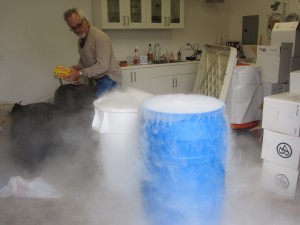Harvest is in full swing in the Russian River Valley, and while our own grapes continue to ripen on the vine, I have been able to secure for myself a half-ton of Pinot Noir grapes from a highly regarded local vineyard. So, I set off on my third attempt to create a world-class Pinot Noir in my recently renovated backyard winery.
Last years effort, though far from a failure, did not achieve the results I wanted. Reasoning that I had the best fruit, and should therefore do as little to the wine as possible, I allowed the fermentation to begin with native yeast, only racked the wine once immediately after pressing, and bottled the wine without filtration or fining. In doing so I was following the received wisdom of the so-called “natural wine” movement, which gets a lot of play. The results were a feminine wine, light in color (I’m told the 2012’s all share this characteristic) and body but with a rich flavor and good balance. However, vibrant fruit was missing, which became very clear when I barrel-tasted the same vintage with our winemaker, Kosta Browne. Admittedly, I’m holding myself up to a high standard, but next to KB’s efforts, my wine tasted a bit flat.
So, This year, I’m back to a winemaking style that I am familiar with from my studies at UC Davis and that I have employed with great success in the past. I am going to emphasize “clean” winemaking over “natural” winemaking, in the hopes that I can better capture that beautiful fruit in the bottle. The major differences that I anticipate this year include:
- A five-day cold soak (I cooled the grapes to about 40 F using dry ice.) The goal of the cold soak is to provide time to facilitate phenolic extraction, the color and taste compounds, in a low alcohol environment, thus minimizing the simultaneous extraction of bitter and astringent seed tannins (which are primarily alcohol soluble).
- Use of enological tannins early in the fermentation to improve color stability.
I will also be re-introducing barrels into my winemaking regime. Last year, I was forced to use oak staves in stainless steel tanks because our winery was under construction and working with barrels in temporary quarters was not practical. Now, I’m the proud owner of two French oak barrels, my favorites!
We’ll see how it goes…
------------------------------------------------------------------------------------------------------------------------


